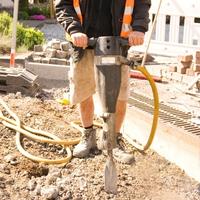Digging post holes in the rocky/hard ground takes more time, and energy and may increase labor costs. So you must be mentally prepared for it & choosing the right tools will be the key.
To dig a few post holes, you can use manual tools such as a digging bar, manual auger, or a post-hole digger.
However, to drill a large number of post holes an auger drill or a jackhammer will be ideal.
This post will discuss digging a post hole in the hard ground using manual to automatic tools.
How to dig fence post holes in the rocky ground?
- Mark spots for fence post holes and decide the size of the post holes.
- Take a digging bar, and start hitting its sharp end to the ground. As the s get loose, remove them from the hole and continue digging until the hole is deep enough for the post’s size.
- For large-area fencing, use a heavy-duty auger drill(bit) according to the post’s width and the size of rocks in the ground.
- A demolition hammer/jackhammer can also break the rocky ground layers easily.
Below we’ve discussed in detail “how to dig post holes in the hard ground.” But before we start digging, decide on the size of the post holes.
1: How deep should fence posts be?
Remember the rule: “⅓ or ½ of the post out of the ground should be buried underground. The post hole must be 2-3 times the post’s width”.
For example, A 10 feet post should be 2.5-3 feet underground.
1: How deep should a 6-foot fence post be in the ground?
A 6 feet fence post should be 1.5-2 feet in the ground.
2: How deep to bury a 16-foot post?
A 16 feet fence post should be 4-5 feet under the ground.
3: How deep should a 12-foot post be in the ground?
A 12 feet fence post must be 3-4 feet under the ground.
2: Dig post holes using manual tools(Digging bar):
We can use several manual tools such as a shovel, post hole digger, and manual auger) for digging fence post holes.
However, the best way to dig through the rocky ground is by using a digging bar. A digging bar is the most practical and economical DIY tool to dig post holes in soft or hard(rocky) ground.
But it may not penetrate through the hard-rock layers. Also, a digging bar takes much longer than an automatic tool such as a jackhammer or a drill.
Steps:
- Start hitting the ground with the sharp end of the digging bar. After each hit, move it left/right & back/forth. It’ll penetrate(loosen) the hard-packed ground & the soil moves aside.
- When sand/stones are gathered in the pit, use a trowel or your hands to remove them out.
- If a heavy rock gets in the way, you’ll feel a vibration in your elbow upon hitting the digging bar.
- Try to loosen the sand around and under the rock with the digging bar.
- At last, fix the digging bar under the stone. Use the post hole’s edge as leverage, apply force on the handle, and the stone will start lifting(loose).

Drawbacks: The digging bar takes a lot of time; hence not ideal for digging more than a couple of holes.
Tips:
- If the hole gets narrow , use the digging bar or shovel to dig soil from the edges of the holes.
- After digging post holes completely, take a tamper tool, and hit it at the base of the hole to level the ground surface.
- If using manual tools, remove the rocks/soil from the hole that gets loose. It’ll reduce manual efforts.
- Cut off any root that comes in the post hole and hinders your work.
Using a manual auger:
A manual auger is also a great low-cost tool for digging post holes. A manual auger also has sharp edges same as an auger drill. Choose the auger size wisely according to the post’s width.
Steps:
- Hold the manual auger from both handles.
- Keep pressing the auger downward and rotate the handles.
- The sharp teeth of the auger will start penetrating the soil, making the hole deeper.
Using a shovel:
A shovel is useful for digging the upper layers of the soil. As the size of stones increases, shovels may become useless. So you can incorporate a shovel with a digging bar to successfully dig post holes.
Steps:
- Drive the shovel on the ground with your feet. The sharp edges will cut the layers of soil.
- Throw the loosened soil/stone out of the hole.
- This way, press the shovel again in the ground and remove the broken sand layers.
- At a point where a shovel can’t dig anymore due to hard rocks, use the digging bar to loosen the hard-set rocks.
Drawback: A shovel may not work if there are large/hard rocks.
3: Dig post holes using an auger drill:
An auger drill is the most used tool to dig heavy post holes in hard ground. As an auger drill is quite powerful, it takes the minimum time and effort.
However, the size of rocks in the earth decides which size auger should be used. An auger drill useable on the soft ground may not work on rocky ground.
You can use a normal auger drill bit to dig t-posts, metal rods, or thin wood post holes. While for setting heavy wood posts on hard ground, you’ll need a heavy-duty auger drill.
So choose an auger drill and bits according to the post size and the diameter of the required hole. The post hole should be twice the post width.
Steps:
The auger drill works such that when we press the auger downward, the rotating sharp edges(twists) drive deep into the ground. The hard-packed ground layers get loose, making the hole deeper.
If the auger is stuck, remove the big stones from the hole to make the process easier.
Sometimes, the auger slips from its original location due to heavy rocks, changing the hole’s location. In such a scenario, refill the hole and dig it back again at the right spot.
While in some cases, if the ground is quite hard(stone layers) and the auger drill cannot dig holes completely. Fill the hole with water and wait a few hours to soften the sand layers.
After you’ve dug the post completely, pour fast-setting concrete in the hole, add water, and then use the auger drill again. The concrete mixture will paste on the hole’s walls, making it more secure. Fast-setting concrete will dry in an hour.
Drawbacks: If a heavy rock is stuck in the ground, an auger drill may be unable to move it.
4. Dig post holes using a Jackhammer:
Jackhammers are usually gas or electric powered and are used to demolish concrete floors and break the hard stone layers in the ground.
A jackhammer won’t completely dig a hole, but it’s the best tool to penetrate the hard-packed rock layers.
Steps:
- First of all, mark the spot for the post hole. Dig a hole up to a few inches using manual tools such as a post-hole digger or a wedge bar.
- Turn on the jackhammer and press it in the post hole. Jackhammer vibrates up & down and penetrates the rock layers.
- After the chisel is completely driven into the ground, pull the jackhammer back and press it in another direction in the hole.
- After the loose sand/stone is filled in the post hole, take it out using a trowel, a post-hole digger, or any similar tool. If nothing is available, you can use your hands.
- Measure the length of the hole using an inch tape.
- If the hole is not deep enough, use the jackhammer again to dig the hole deeper. After that, remove the loose sand through the hole again.
- Repeat all the steps until the hole is deep enough for the fence post.
Drawbacks: If a heavy rock is stuck in the way, an auger drill may be unable to dig further.
Conclusion
A digging bar is ideal for digging a few post holes. But it’ll take more time and energy, according to the hardness of rocks and soil. While a jackhammer is perfect for drilling(demolition) through the hard rock layers.
If you are installing a fence over a large rocky area, an auger drill is the most time & energy-saving tool. Make sure to use a heavy-duty auger according to the diameter of the fence post and the size of rocks in the ground.
If you still need any guidance, ask us in the comments below.
Related Guides:

